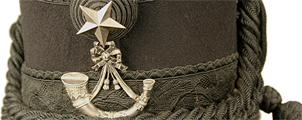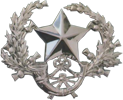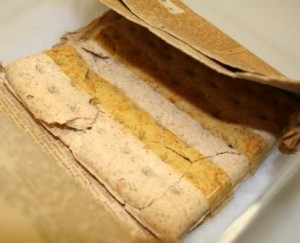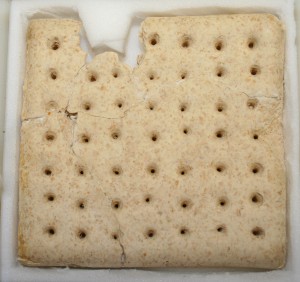British Army ration biscuits
Army issue biscuits or ‘hard tack’ have been a staple part of ration packs throughout the history of the British Army. Within our collections at South Lanarkshire Leisure and Culture we have three such biscuits. One is wrapped in the pages of The Glasgow Herald dated 13th October 1900 and dates from the Boer War. The second dates from the early 20th century, most likely from the First World War and the third is from the Second World War.
During the First World War British troops consumed approximately 4,500 calories a day. Whilst this sounds a substantial amount, food at the front was often poor quality and rations could be sporadic. Feeding an army was logistically, a complex task. Supply lines were often affected by fighting and shortages were prevalent. By the end of First World War there were over 2.3million men at the Western Front alone. The food supplied was often monotonous and at times inedible, however, in comparison to French and German troops, the British were believed to have been relatively well fed.
There was no official standard army ration during the First World War but all men received roughly the same allowance. Colonel H.H. Story M.C. states in The History of the Cameronians (Scottish Rifles) 1910-1933 that the rations issued to the 19th Infantry Brigade during the winter of 1914-15 were as follows,
Bread/Biscuit: 1lb
Meat: 12oz
Vegetables: 8oz
Bacon: 4oz
Sugar: 3oz
Jam: 4oz
Butter/marg: 2oz
Cheese: 3oz
These were issued daily with the exception of butter which soldiers received twice a week. Meat was usually tinned known as ‘Bully beef’ or issued as the infamous ‘Maconochie,’ a mixture of fatty meat, vegetables and gravy. The food often had to be eaten cold and the men had to prepare their meals themselves whilst at the front. Bread was scarce, particularly in 1916 when there was a flour shortage. Men often had to resort to ‘biscuits’ made from salt, flour and water. In 1914 Huntley and Palmers were contracted by the British government to produce the No.4 standard Army Biscuit, so called as it was approximately 4 inches square. At the time Huntley and Palmers were the world’s biggest biscuit manufacturer and had even supplied Captain Scott with biscuits on his expedition to the Antarctic in 1911.
These ‘hard tack army biscuits’ were incredibly tough and often had to be soaked in tea or water for some time before consumption. Sometimes they were ground down to use as a thickening agent (known as ‘duff’) for stews. Other men found more novel uses for the humble but durable biscuit. Some used them as postcards by writing messages on the surface and posting them home to arrive at their destination intact. Others used them as a blank canvas to paint or draw on, but perhaps one of the most popular uses was as a photo frame. The frame was created by carving out the centre and placing a photograph in the hollow.
Whilst many found humour in the hard tack biscuits others were angered by the poor quality food that they received. One biscuit in the collections of the Imperial War Museum, North bares the handwritten message, “YOUR KING AND COUNTRY NEED YOU AND THIS IS HOW THEY FEED YOU.”
The fact that so many of these biscuits survive today, 100 years after their production, is testament to their durability and perhaps the incredulity of many men who kept these biscuits not only as mementos but as physical evidence of the diet that they were subjected to.
Comments: 0






Leave a Reply